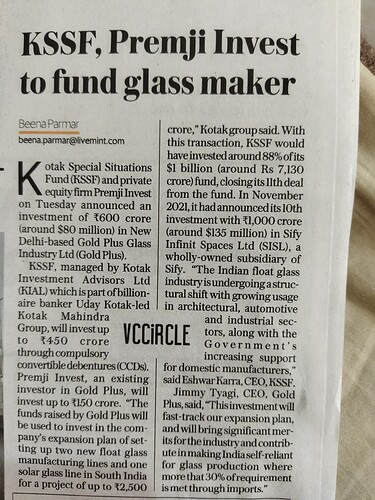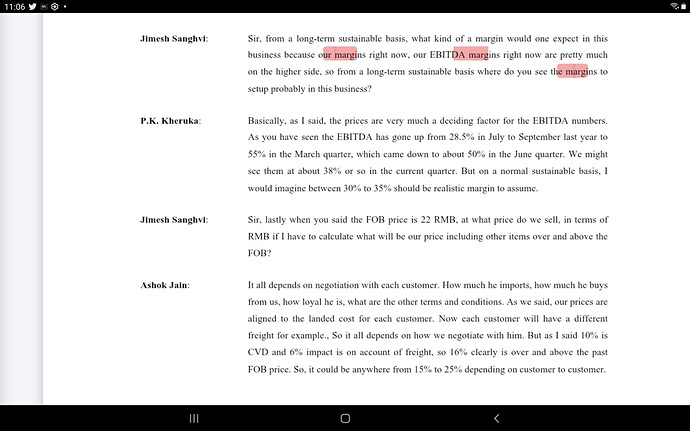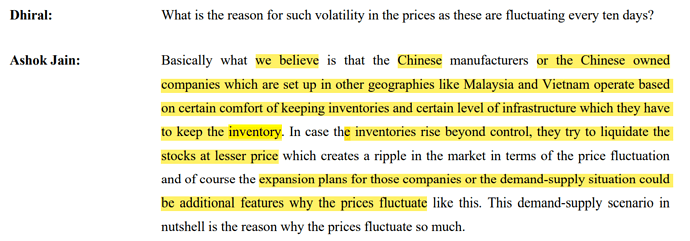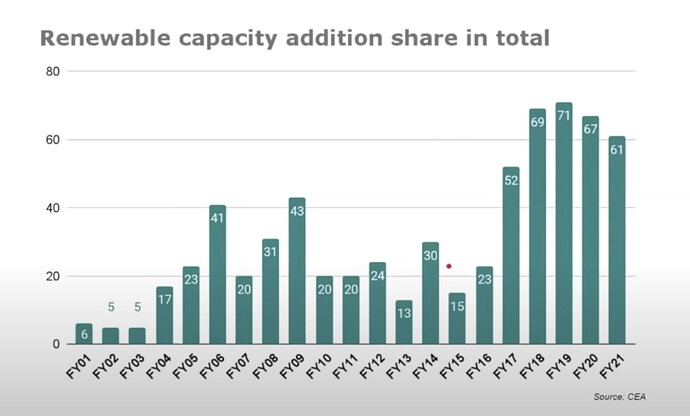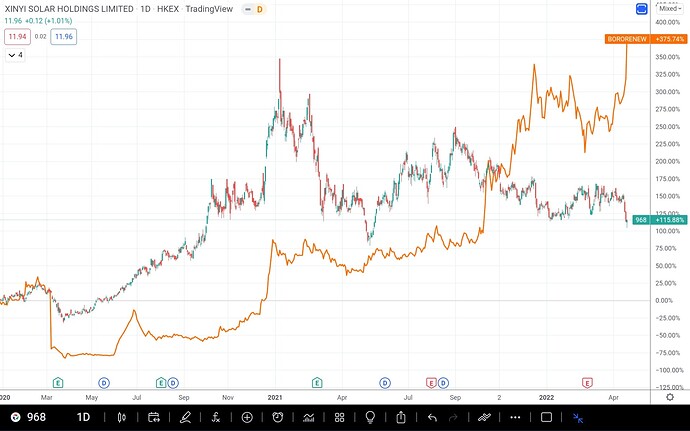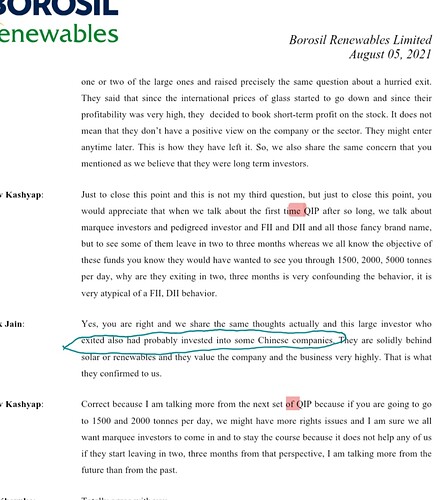Thanks. So that answers my question on delta margins are commodity factors and not value driven hence not necessarily repeatable.
Borosil Renewable Q3FY22 Concall Notes
- Prices were Rs 141.5 per square mm which helped them offset some of the inflation in input costs
- Soda Ash, main raw material, costs were lower as they had a contract in place, this contract expires in April and new contract will be signed. Soda Ash prices in Q1FY23 are expected to rise for them due to this new contract in place
- Because input costs were lower (soda ash contract) and realizations were higher, they were able to clock in 41% OPM this quarter, guidance is lower on future quarter’s margins
- Company has achieved last year’s EBITDA in just 9M of this year
- They are in advanced discussions with large solar module manufacturers to lock in solar glass supply contracts, pricing for this contracts will be based on a formula (My guess is this is either Reliance or Waaree)
- Industry is shifting to 2mm glass, margins are slightly higher for them in thinner glass, output yield for them is also higher in thinner glass
- Expect demand for thinner, bifacial and larger modules to increase. Currently total sales for thinner glass is around 30%
- They have 35% share of solar glass market in India
- Big demand from countries like US, Turkey and Europe, they want to balance supply to domestics and exports, can ramp up export supply at any point, no shortage of demand
- SG3 Capacity coming online in Q2FY23, they will first start utilization at 85% of furnace to be on a safer side before ramping up to 100%
- Input prices have risen, prices of solar glass from China have reduced, combined two can lead to a dip in margins in next quarters, they do not foresee 41% margins sustainable
- No plans to increase capacity beyond SG5 (once SG5 is functioning, they will have 12.5GW of yearly solar glass capacity)
- Anti-Dumping Duty for solar glass from China ending in July, have filed to extend it | If duty is not extended, margins will reduce, no comments on how much, have a good case to extend anti-dumping duty
- They do not buy any natural gas from export markets, all gas is supplied by GAIL on the basis of long term and medium term contracts (3lakh cubic meter per day of natural gas requirement), negotiating with GAIL for medium term contract supply of gas for SG3
- No warranty on Solar Glass, Quality Claims and Breakages are dealt with ad-hoc
- Cost Cutting measures are being implemented across, by Oct 2022, 30% of power supply will come from solar and wind sources (not allowed to extend it beyond 30% by regulation, would have extended even further if Govt allows)
- 99.5% of raw material is sourced domestically, few chemicals are imported
Based on the above my sense is they can do 30% margins next quarter at minimum and will still report topline above 150cr. Q1FY23 is the main quarter to look at as soda ash contract will be renegotiated which can lead to margin impact.
While newer capacities will take time to commence ,esp the greenfield, given Borosil renewables takes 1.5 yr+ for brownfield.
They seem to have consciously chosen South geo, Borosil renewables is west based. Freight is an imp element when eventually multiple players exists and Competetion drives margins.
Enough room for now to accommodate multiple players. Also shows attractive industry economics.
Finished reading the Xinyi Solar interim report 2021
Available publicly, link: 211131-02 (xinyisolar.com)
Key takeaways:
-
Xinyi is the leading solar glass player with a capacity of 11,800 TPD as of 30 June, 2021 and further announcements of 16 lines of 1000 TPD each, of which 8 lines are targeted to be completed in 2022 and timeframe for rest not determined yet. Global capacity is currently close to 20,000 TPD but will go up rapidly as implied from Xinyi’s expansion plans.
-
Mainland China vs. exports revenue split as of H12021 is ~70:30. Export contribution has gone up YOY (31.9% vs. 27.9%) to fulfill orders by customers based in Southeast Asia and India.
This implies exports is a thrust market for them given the geographical asymmetry in solar glass supply. Indian market demand gap should get fulfilled soon though that might not be a threat to BRL since domestic customers find it more convenient (quicker TATs) to buy from a local player (Product is widely accepted). But this rapid supply increase could have implications for solar glass price. -
Solar glass prices peaked in 1st quarter 2021 (Mar FY21 qtr) and then dropped significantly. This was primarily due to demand pressure in downstream supply chain (PV module, solar farms etc…), and secondarily due to increase in industrial supply of solar glass.
The downstream demand slowdown was due to increase in prices of polysilicon & other auxiliary materials (RM for PV modules) and supply chain logjams, thereby increasing the module prices, thereby resulting in lower than expected growth in solar PV installations and projects.
In long term, once the supply chain crisis moderates and commodities cool off, we could see another spike in solar glass prices. However, I believe these should be temporary given the ability of Xinyi to scale at a rapid pace. Hence, banking on solar glass prices could be a futile exercise (even if you are invested in Xinyi :)) -
Xinyi solar glass margins:
- Solar glass GM - 51.2% H1 2021 (elevated solar glass price in Q1) vs. 38.9% H1 2020 (closer to current prices)
- For BRL, H1 2021 (mar '21 & jun '22 qtrs) GM was close to 50%
- Overall GM (glass+farms) - 55.4% vs. 47.3%
This is because the other business area - solar farms & EPC - accounting for roughly 20-25% revenue, has a GM of 73%, though the growth was lower than solar glass segment.
May be an area for boro to focus in deep future as it tries to latch on to adjacencies. - Overall EBITDA margin (glass+farms) - 57% vs. 51%. Operating expense split not available, hence an EBITDA comparison with BRL not possible
- Further plans apart from capacity expansion (Pretty much in line with BRL):
- Exploring upstream RM resources to ensure a stable supply and alleviate the pressure from rising prices
- Focus on large format and thin solar glass (higher value added)
- Cost controls, improved production tech and development of new products
My question: The only real downside imo to this biz is inability to control solar glass prices. What prevents solar glass price from going below the historical mean levels? I see 2 ways:
- If commodity prices remain elevated in long term resulting in slowdown of downstream demand → unlikely, as polysilicon supply should catch up with demand and supply logjams resolving in long term
- Rapid competition - Price war - > Why isn’t this happening already? biz economics is attractive with ROCE>cost of capital. Is there an entry barrier that we are missing? Mr. Kheruka did imply in one of the concalls that solar glass making has a steep learning curve. However, steep doesn’t mean it will never happen. Any case study of similar situation where a small local player has competed successfully with a global giant in a commodity setting?
Disclaimer: Invested in BRL. Views are biased. Not an investment advice.
I think what you’re missing here is the larger picture. The global demand for solar is quite high right now. India plans to install 500GW of RE by 2030. That’s an additional 400GW from 2021 levels. Out of that 400GW, 280GW will come from solar. Now compare this with around 10GW of solar module manufacturing capacity that India had in 2021.
To ensure the targets are met in approx 9 years, we need to install 44GW of solar every year and that means an equivalent solar module capacity and hence an equivalent solar glass requirement. So effectively, there is scope to effectively 4x capacity here without hurting the supply / demand dynamics.
And all of it is assuming 0 exports, which isn’t the case. Add to this the high duty levied on imported solar modules. Net net - super strong industry tailwinds leading to high ROCEs coupled with some amount of technical barrier to climb ----> super strong economics for existing well established players.
Appreciate your response.
-
India has a RE target of 175 GW by end of 2022, of which 100 GW has to come from solar. Nowhere close to that currently. Hence, what gives us confidence on 2030 projection?
-
Still, lets assume there is a big runway ahead. My question is more towards entry barriers for the industry. If all is rosy, we should see increased competition in future unless there are entry barriers. This could drive down the solar glass prices and reduce the extraordinary GMs enjoyed by the industry. Basically, how is the downside of solar glass price protected?
Past decade- chinese & Malaysia( units of chinese setup) suppliers have in past killed the global solar glass industry, including bigger players like Asahi & Saint gobin etc. BRL was barely surviving - from inception till FY 21 BRL had single digit to mid teen margins at best.
What has changed since
- Renewable at inflection point and a strategic focus for Govt around the world, this is accentuated further with current world order and insecurity around Fossil fuels - point being Structural demand much ahead of supplies
- Realization of China being critical failure point in supply chain, hence structural China+1 theme
- Protection Measures by India on duties, local industry incentives in PLI etc
- New capacities are being setup in India , BRL + others
Mr Khureka has answered this question on sustainability of margins in absence of duties in recent concall and rational , indicating a sustainable long-term margin range of 30-35%, this is a conservative management and used to shy from any such guidance till some time back
Energy security is non negotiable for India and other countries, Mr Khureka also alluded to 25% Biz from exports to other countries on sustainable basis, so BRL can not only sustainably complete locally, it can do same globally.
Another important aspect is operating leverage as additional capacities kick in from Mid 22, BRL expects few% point positive impact on EBDITA. Add to it various cost measures on energy etc.
What used to be function of solely China glass price is now China glass price++( multiple factors/levers at BRL level + Policy support on duty and DCR + Freight dynamics etc).
Q4 and Q1/Q2 should give true resilience of business economics, as both headwinds and tailwinds converge. Last few quarters aren’t sustainable, where most of things worked in BRL favor. Mgmt is cognizant and hence calibrated capacities expansion, without stressing balance sheet.
Not an expert, but this quote from Q3FY22 con-call provides some context on how Chinese players price solar glass -
All said and done the valuation is not cheap at cmp and any sanctions by US on India May impact the commodity prices affecting the overall industry.
If you consider the fact that from June onwards, the capacity is going to be doubled, then valuations would look more attractive. Add to it another capacity expansion next year.
Upcoming Developments to watch out for:
- from 1st April 2022, 40% basic custom duty on imports of solar modules & 25% basic custom duty on imports of solar cells will be levied.
- In July 2022, SG3 will be operational.
- In August 2022, end of Anti Dumping Duty on chinese solar glass imports.
Last 4-5 years, the incremental addition of renewables to total has been > 50% consistently. Never seen before
Above article is from Sept 21 - expect by 2025, demand to catch up with supply, we didn’t have Russia Ukraine War back then, energy crisis is higher and China is still having sizable lockdowns. Demand could well stay ahead of supply for longer than anticipated.
For trend purpose- Per Jan 22 export Data solar glass export HS Code - 70071900- stands at 20 cr, ( Q3 monthly avg for export was 15 cr) - Borosil has indicated exports to be sub 30%, implies Q4 topline could be better than Q3, anyways results to be out soon. Besides one Qtr number, mkt will be keen to watch on margins- has oscillates between 35 to 50% range in last 5 qtrs. No of triggers lined up
- Capacity going from 450 TPD to 2X+
- Next leg of Capex to take Capacity near 5X
- Co is generating healthy cashflows ( at conservative 1300 cr+ runrate and 35% margins, FY23 EBDITA to be around 450- cr at full capacities including new), given debt free status- as of now can pump 300-350 cr+ cash if realization stays healthy. Implies largely accruals based Capex
Post Q1 23 new capacities coming online at 450 cr EBDITA, 320 cr+ Profit, Current mkt cap is 8400 cr. Capacities further lined up for 2X+ from FY23 base.
The only major concern is operating margins, in some of the interviews the management has commented that they expect the margins to go down once the global supply chains come back up properly . Also the raw material prices of soda ash is going up and energy cost is also increasing both making a crucial part of their cost .
Board meeting on 25th April for fund raising. Looks like a QIP or preferential share issue. As a shareholder, I would much rather have rights issue for equitable distribution of benefits (unless marquee investors come in at premium valuation in QIP, then I am fine  )
)
A peek into Chinese biggies vs Boro renew, Divergence visible from No/ Dec 22 onwards, this was the time when energy cuts, winter Olympics, now sever lockdowns are the key events in China causing major disruptions. In crude terms a rebound in Xini would indicate something on global glass supply front.
Remember Institutional investors selling shortly right after QIP allocation in last round and mgmt indicated buying global competetion as a probable reason, Karma as they say it ![]()
BN will hopefully play it with this past experience more carefully this time.
company has done an acquisition and will issue shares in the company.
they have acquired a 300tpd capacity company and a glass trading company.
Some part of the consideration will be in form of cash.
The shares are priced at a premium and company is using that as the currency, I think its a smart move.

